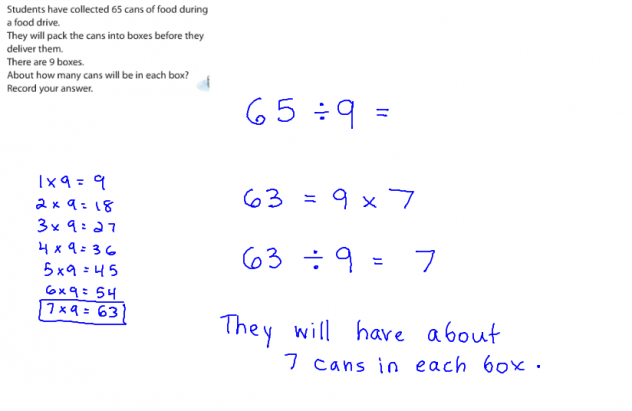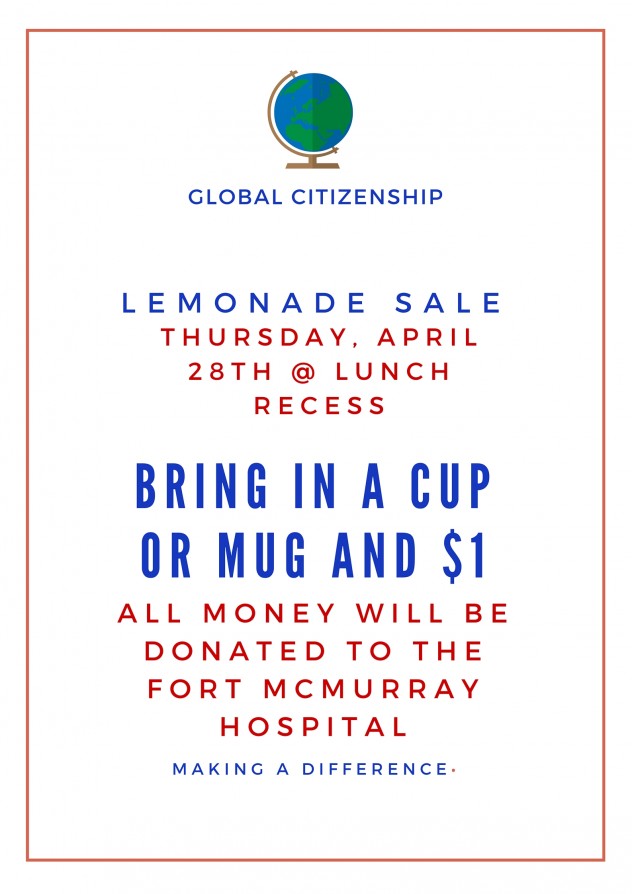Did You Know…? Whales are divided into ‘toothed whales’ and ‘baleen whales’. Instead of teeth, baleen whales have a thick curtain of bristles hanging from plates in their upper jaw. These are made of keratin, like human hair and fingernails.
Good afternoon,
The Grade 4 students and I continued to practice estimating quotients today. Today’s example was:
When solving the problem (65 ÷ 9 = ), you can use your 9x tables to help you to estimate. We already know that 7 x 9 = 63. That means that 63 ÷ 9 = 7. So, they will have about 7 cans in each box. Don’t forget to use the word about to indicate that you are estimating. Unfinished practice questions were sent home for homework.
In Health today, the students and I tested out their “6-Block Problem Solving” method from last week. The students had been asked to consider how they would move a balloon from one end of the room to the other without their hands or feet. Students had to include their entire group (in some way). The majority of our groups were successful, largely due to the above problem solving method. When you take the time to consider what will happen, you are more likely to arrive at the best solution. It is also important to take time to reflect. Were you successful? If not, what could you do differently next time (don’t give up!) If you were, what would you keep the same? What would you change? It is important that we practice learning from our mistakes. Students have been given a problem called “The Strawberry Dilemma” that they have been asked to complete at home. An important aspect of our FRIENDS work is to have students sharing what they are learning with their families. Please take time this week to help your student plan and implement a solution to the “Strawberry Dilemma.” This activity should be completed by next Tuesday, May 3rd.
In Science today, the Grade 4 students and I continued to talk about light. Why is it that you can see some objects and others you cannot see unless there is light? The difference is that some things emit light while others reflect light. Some things produce or give off their own light (emit); such as: the sun, light bulbs, etc. Other things are visible because they reflect surrounding light. Everything we can see is reflecting light, however, some things are better reflectors of light than others. A mirror’s smooth, shiny surface makes it a great conductor of light. Some examples of things that reflect (not emit) light are: rainbows, the moon, etc. In fact, the moon is commonly mistaken as something that emits light. Don’t be fooled! The moon doesn’t really “shine;” it reflects light from the sun. Check out the video below:
We also began discussing luminescence today. Some things emit their own light because they luminesce. Unlike other things that emit light (eg. the sun), luminescent things don’t get hot. Luminescence takes place in a range of temperatures that don’t burn other living things. Some animals are able to luminesce; like an angler fish. Glow-in-the-dark objects luminesce, usually due to a chemical reaction; like glow sticks. We will continue to discuss objects that luminesce next class.
The Grade 5 students and I reviewed mechanical mixtures, such as the solid+solid mixtures we were working on separating last week. Remember, in a mechanical mixture, the particles are distinguishable for one another. They are a heterogeneous mixture:
A heterogeneous mixture is a mixture that is made up of different substances that remain physically separated. Today we turned our attention to some other types of mixtures. We created a suspension and a solution. To do this, we made lemonade! To begin with, we mixed water and lemon juice. Students noticed right away that while most of the juice particles were evenly distributed with the water, that some of the larger particles (eg. pulp) had started to separate toward the bottom. Due to this, the lemon juice and water could be said to create a colloid. A colloid is where fine particles are dispersed throughout another substance. They generally give off a “cloudy” appearance.” The larger particles were suspended in the mixture, creating a heterogeneous mixture. Next, we added sugar. We did not stir the sugar. We observed the sugar being added to the mixture. At first the particles simply settled in a pile on the bottom of our cups, and the mixture did not taste any sweeter. This is another example of a heterogenous mixture. We could see the different components. However, our next step was to stir. We stirred the sugar until it was dissolved in the water. Water dissolves sugar, creating a solution. Solutions are homogenous mixtures. The components are distributed evenly throughout; you cannot distinguish one from the other. All in all this was a pretty “sweet” way to begin exploring solutions and solid+liquid mixtures. Our first method of separation? Evaporation. We are waiting to see how long it takes for the water from our lemonade to evaporate and to see what gets left behind!
In Art today, we continued to work on our projects from last week. This week students were asked to critically examine their first drafts; use the “eye of a scientist.” Then students were allowed to create their second draft. Second drafts should contain the components that students liked from their first draft, but should have changes to the things that they didn’t like. This is also the opportunity to add details such as background, props, etc. Make the picture your own! Students were able to redraft their work until they were comfortable with their end result. Then students could begin their final drafts! Final drafts are completed on white paper. Students are able to choose their own medium. Today students could choose from markers, pencil crayons, crayons, sharpies, oil pastels, and watercolour paints. We will be finishing these projects next week. I can’t wait to see our final product. If you’ve enjoyed working on our Harry Potter Fan Art, be sure to check out these videos below:
Agenda:
Read 20 minutes
Language Arts:
- Mouse and the Motorcycle – Chapter 3
Math:
- Gr. 4 – pg. 300-301 #3, 5, 8, 10
- Gr. 5 – Mathletics (Equivalent Fractions)
Health:
- FRIENDS – Home Activity 8A (Tuesday)
Grade 5/6 Floor Hockey – Wednesdays 3:00-4:00 pm
Floor Hockey Tournament – May 6th-7th
STEM Club – Mondays, Thursdays 3:00-4:00 pm
Book Orders – April 28th
Spring Picture Day – April 27th
Yearbook Orders – extended until April 28th
2nd Annual Robotics Dinner & Social – May 5th @ Walter and Gladys Hill School (buy tickets online at: http://tinyurl.com/fmpsdsocial)
Grade 3 Hospital Donation Drive – bring $1 + mug/cup for lemonade (Thursday)



